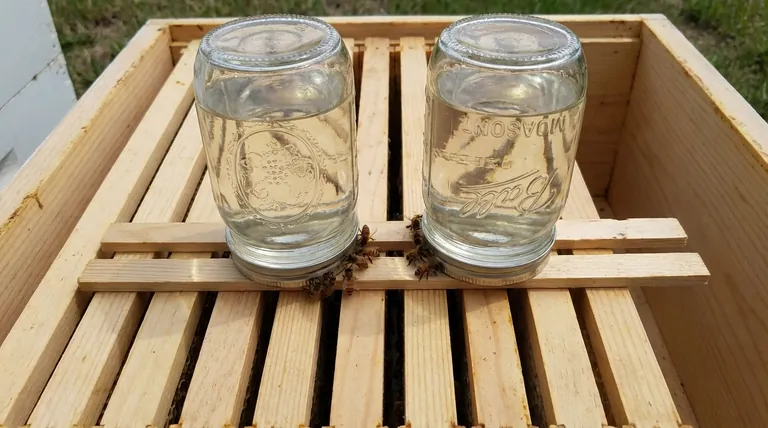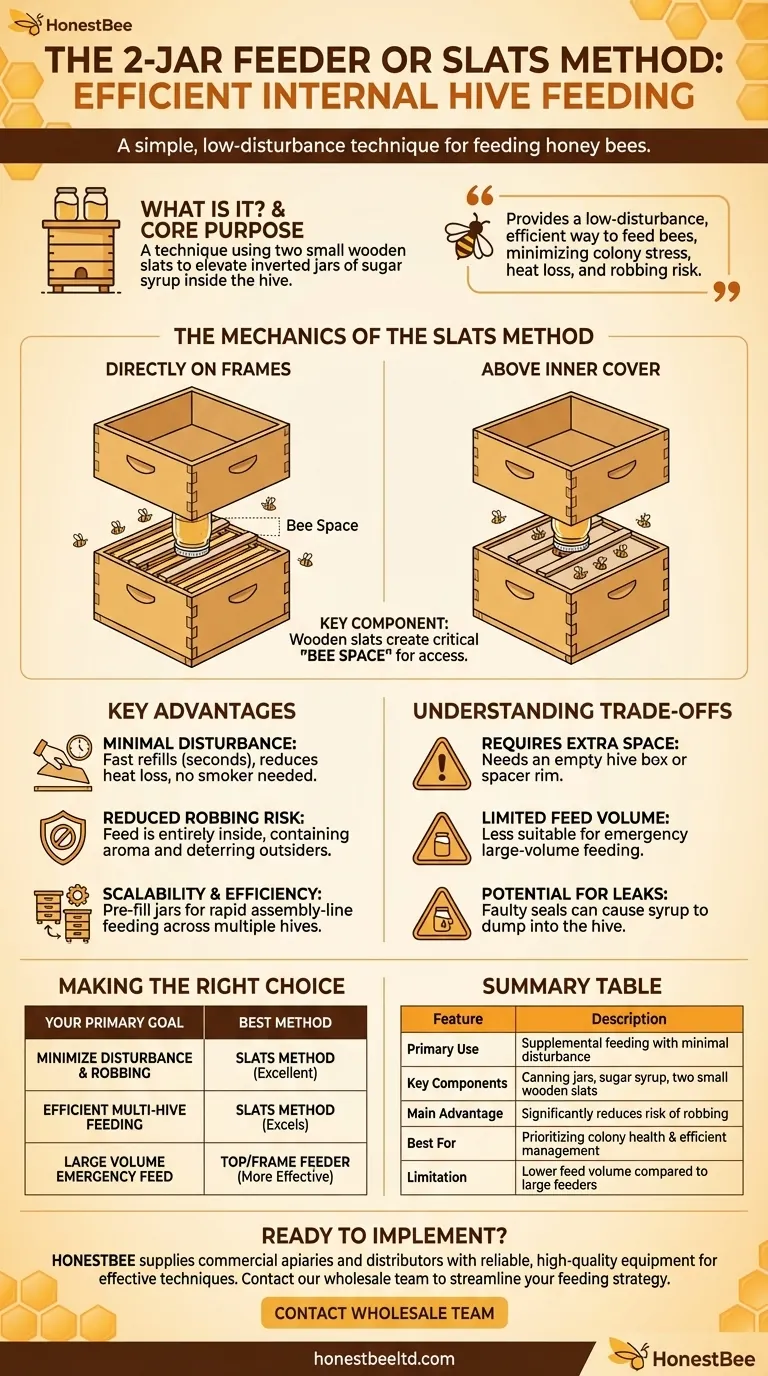In beekeeping, the 2-jar feeder, or slats method, is a simple technique for feeding honey bees inside the hive. It uses two small sticks of wood, or "slats," to elevate inverted jars of sugar syrup just enough to allow bees to access the feed. The jars are placed either directly on the top bars of the frames or over the hole in the inner cover.
The core purpose of the slats method is to provide a low-disturbance, efficient way to feed bees. It minimizes colony stress and heat loss during refills while significantly reducing the risk of attracting robber bees from other hives.

The Mechanics of the Slats Method
The elegance of this method lies in its simplicity. It relies on basic equipment and the natural behavior of bees to create an effective internal feeding station.
The Core Components
The system requires only three things: standard canning jars with lids, the sugar syrup feed, and two small wooden slats. The slats are typically about the thickness of a pencil or paint stirrer (around 1/4 to 3/8 inch). The jar lids are perforated with a handful of tiny holes, just large enough for bees to feed through.
Creating Critical Bee Space
The wooden slats are the key to the entire system. When an inverted jar is placed on a flat surface, its lid sits flush, preventing bees from reaching the holes. The slats elevate the jar lid just enough to create "bee space," allowing them to crawl underneath and access the syrup.
Two Primary Placement Options
- Directly on the Frames: The slats are laid across the top bars of the frames in the uppermost hive box. The inverted jars are then placed on the slats. This puts the feed in direct contact with the bee cluster.
- Above the Inner Cover: The slats are placed on either side of the hole in the hive's inner cover. The jar is then inverted over the hole. This method is even less disruptive, as the beekeeper doesn't need to expose the frames at all during a refill.
In both cases, an empty hive box must be placed on top to enclose the jars and provide space before the outer cover is replaced.
Key Advantages of the 2-Jar Method
Beekeepers choose this method for several distinct benefits, primarily revolving around efficiency and colony health.
Minimal Colony Disturbance
Refilling the feeders is exceptionally fast and calm. The beekeeper simply lifts the outer cover, swaps the empty jar for a full one, and closes the hive. This process takes seconds, minimizing heat loss and avoiding the need for a smoker, which reduces stress on the colony.
Reduced Robbing Risk
External feeders, like entrance feeders, can leak syrup and create a strong scent that attracts bees and wasps from other colonies. This can trigger a "robbing" frenzy. By keeping the feed entirely inside the hive, the slats method contains the aroma and makes it much harder for outsiders to locate.
Scalability and Efficiency
For beekeepers with multiple hives, this method is highly efficient. Dozens of jars can be prepared in advance. During a yard visit, the beekeeper can quickly and quietly move from hive to hive, replacing feeders in a fraction of the time it would take to fill other feeder types.
Understanding the Trade-offs
While effective, the slats method is not the perfect solution for every scenario. It's important to understand its limitations.
Requires Extra Hive Space
To use this method, you must place an empty hive box (or a shallow spacer rim) on top of the colony to enclose the jars. This is an extra piece of equipment that you must have on hand.
Limited Feed Volume
A standard mason jar holds significantly less syrup than a large top feeder or a frame feeder. This makes the method less suitable for emergency feeding where a weak colony needs a large volume of syrup immediately. It is better suited for steady, supplemental feeding.
Potential for Leaks
If a jar lid is not screwed on tightly or the seal is faulty, the vacuum can break, causing the entire jar of syrup to dump into the hive. This can drown bees and create a significant mess that needs to be cleaned up promptly to prevent pest issues.
Making the Right Choice for Your Goal
To decide if this method fits your needs, consider your primary objective for feeding.
- If your primary focus is minimizing hive disturbance and preventing robbing: The slats method is an excellent choice due to its speed and internal placement.
- If your primary focus is efficiently feeding many hives in an apiary: This method excels, as you can pre-fill jars and swap them out with assembly-line speed.
- If your primary focus is delivering a large volume of feed to a starving colony: A large-capacity top feeder or frame feeder is likely a more effective tool for the job.
Ultimately, the 2-jar slats method is a valuable, low-cost, and highly effective technique that belongs in every beekeeper's toolkit.
Summary Table:
| Feature | Description |
|---|---|
| Primary Use | Supplemental feeding with minimal hive disturbance |
| Key Components | Canning jars, sugar syrup, two small wooden slats |
| Main Advantage | Significantly reduces risk of robbing by containing feed inside the hive |
| Best For | Beekeepers prioritizing colony health and efficient multi-hive management |
| Limitation | Lower feed volume compared to large-capacity top feeders |
Ready to implement the efficient 2-jar slats method in your apiary? HONESTBEE supplies commercial apiaries and beekeeping equipment distributors with the reliable, high-quality supplies needed for this and other effective beekeeping techniques. From durable jars to essential hive components, we support your operation's success. Contact our wholesale team today to discuss your needs and streamline your feeding strategy.
Visual Guide

Related Products
- Professional Hive Front Entrance Bee Feeder
- Boardman Entrance Bee Feeder Durable Galvanized Steel and Wood Construction for Beekeeping
- HONESTBEE Professional Entrance Bee Feeder Hive Nutrition Solution
- In-Hive Dual Compartment Frame Bee Feeder for Targeted Colony Nutrition
- HONESTBEE Entrance Bee Feeder Efficient Hive Front Liquid Feeding Solution for Beekeeping
People Also Ask
- What is an entrance feeder and how is it used? Avoid the Critical Risk of Robbing
- Are entrance feeders good for bees? Prioritize Hive Health Over Convenience
- What are entrance feeders, and where are they located? A Guide to External Hive Feeding
- How does a beehive entrance feeder work? A Simple Guide to Supplemental Feeding
- How do you make an entrance feeder for bees? A Guide to Safe & Effective Hive Feeding



















